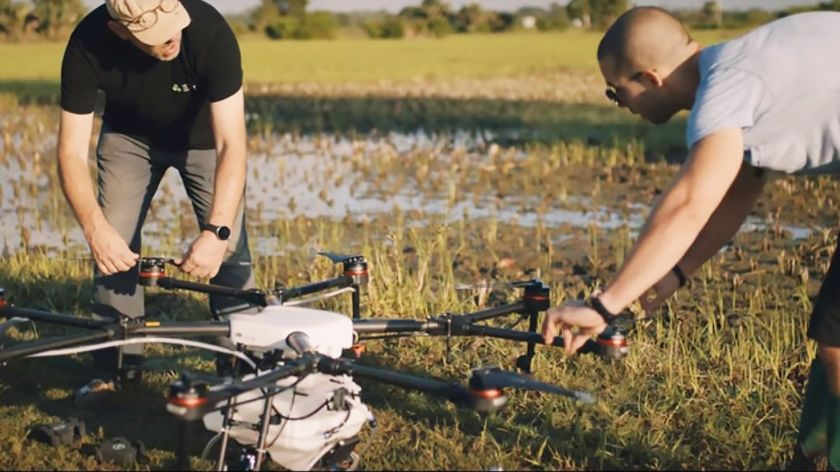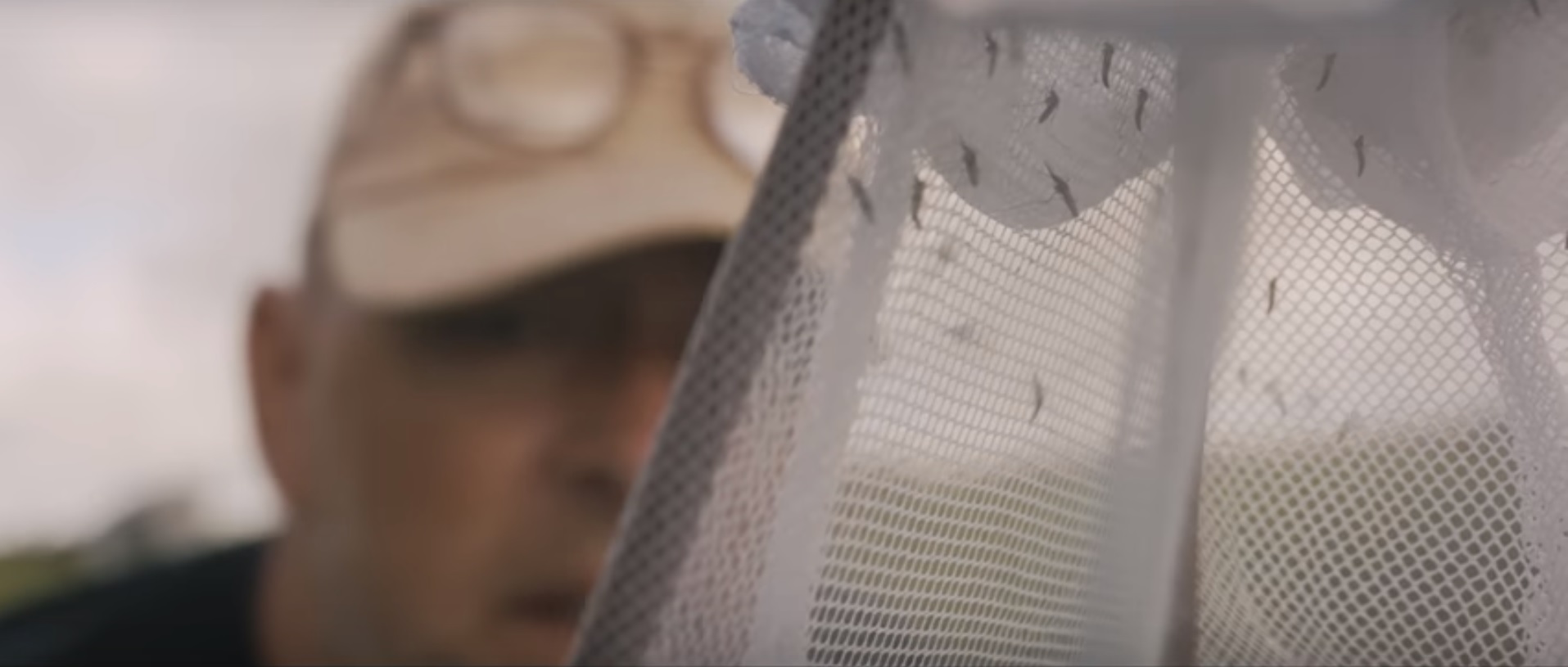Drones latest weapon in fight against malaria
-
 Still Youtube-video DJI
Still Youtube-video DJI
If medical entomologist Bart Knols gets his way, drones will be the future of the fight against malaria transmitting mosquitoes. A pilot study in Tanzania ended last December. ‘The number of mosquitoes decreased by around 90 percent.’
Bart Knols (54) is standing next to the table in the living room of his house in Dodewaard. In his hands is a mosquito net with the logo of football club Manchester United printed on it. ‘Look’, he says gesturing gleefully. ‘This is so great. With this, there’s no more need to force a seven-year-old boy, a die hard Manchester fan, to sleep beneath a mosquito net.’
Knols teaches Health & Innovation at the Faculty of Science two days a week. The medical entomologist fills the remainder of his time with his own (research) projects. Fighting diseases transmitted by mosquitoes – such as dengue fever and malaria – has kept his interest throughout his scientific career. His preferred approach is through innovative applications – like the imprinted mosquito net.
Drones are the latest addition to Knols’ arsenal in the fight against the Anopheles mosquito – the genus that transmits malaria. These drones spray a biodegradable liquid across huge rice fields – the breeding grounds of the mosquitoes. The substance causes a massive mortality among larvae and thus tackles the root of the problem. A trial with drones in Zanzibar set up by Knols ended last December. The entomologist is still working on a scientific publication.
What can you tell us about the pilot?
‘We tested on nine rice fields. We sprayed three fields with one millilitre of biodegradable liquid per square metre and three other fields with five millilitres per square metre. We also sprayed three fields with water and used those as a control group; the only difference in treatment was the composition of the liquid. We then placed traps over the water in the form of small tents made of mosquito netting. Every morning, we counted the numbers of mosquitoes trapped. We also took water samples to count the larvae.’
How does the liquid work?
‘The substance, called Aquatain, forms a film – or thin layer – on the water changing its surface tension. It already existed and has been used to prevent evaporation of water. In 2009, I investigated whether it could also be used against mosquitoes. Hatched larvae hang off the water surface by their abdomens, where their breathing tube is located. The lack of surface tension caused by the film makes them sink continuously; staying near the surface takes a lot of energy, and at some point, they get exhausted and die. As for the mosquitoes that want to lay eggs on the water: they sink and drown because of the film.’
What were your findings?
‘In the fields where we sprayed Aquatain, the number of mosquitoes had dropped by 90 to 95 percent. This applied to both the fields where we sprayed one millilitre and those with five millilitres of substance. In the control fields, the mosquitoes kept hatching in large numbers. After a month, the population started slowly increasing again, as the UV in sunlight degrades the film.’

Knols was presented with the idea of fighting mosquitoes using drones in 2015, when Guido Welter (a German drone fanatic) approached him through his website. Through crowdfunding, the men raised sufficient resources to start a pilot. The choice was made to do that on the island of Zanzibar, an autonomous region of Tanzania, off the east coast of Africa. The entomologist works together with a flying lab – a local organisation that experiments with drone use in various applications, such as surveying.
The pilot proved successful. However, this was a single rice field. What about the rest of Zanzibar and Tanzania?
‘The rice ecosystems are often large cooperatives. A large number of farmers lay their fields next to each other, which creates one very large area. Such a field can be taken care of in no-time. We can spray a hectare of land in just a few minutes. We actually want to transfer the entire technology and approach to a young Tanzanian start-up. That start-up would make agreements with those cooperatives: “we spray your lands, and you pay us”. Then they go to the next rice field and offer the same there. That way, they can sustain themselves.’
That almost sounds too good to be true.
‘If I had to point out points of worries, I would say: the cost of that large drone. It is around fifteen thousand dollars – a major investment. But for someone like Bill Gates (former head of Microsoft who spends large amounts of money on fighting malaria, ed.) or bodies such as UK Aid or the Dutch embassy, it’s barely the cost of a cup of tea.’
According to the WHO, 228 million people were infected with malaria in 2018 alone, and 405 thousand perished in that year. This is comparable to seven jumbo 747s crashing every single day, Knols says. ‘The numbers are estimates’, he believes. ‘The probability that the death of a child in the middle of the Congo or Central African Republic be attributed to malaria is virtually zero.’
How realistic are the chanced of this project truly getting off the ground throughout Africa?
‘To be honest, I think that chance is currently rather small. That has nothing to do with the idea itself; it is biologically achievable. No, it has to do with politics. There are powers working against you. If you were to go to Africa right now, put your flag somewhere and say “Gee, let’s eradicate malaria here”, someone from another body, like the Liverpool School of Tropical Medicine, for example, would be tapping on your shoulder in no-time. They would say that you cannot simply eradicate malaria there, because they are carrying out their own research in that area. Everyone does their own thing, without wanting to collaborate. I sometimes wonder which intentions we researchers have. Is it all about publications in leading journals, or are we trying to provide solutions to problems?’
Fighting mosquitoes would also disrupt the local ecosystem.
‘I hear that argument quite often. If we kill those mosquitoes, swallows and bats will lose their source of food. That’s not the case. Less than 5 percent of the swallows’ and bats’ diet consists of mosquitoes. Besides, I feel this discussion is very much pointing a finger at Africa. Every single tree in the Dutch ecosystem has been planted. Then we turn to Africa and say: “you have to keep those mosquitoes alive”.’
All previous attempts at eradicating malaria have failed.
‘Fighting malaria was particularly successful between 2000 and 2015, thanks to mosquito nets and insecticide. The mosquitoes mostly bite in the bedroom at night. These days, we see mosquitoes adapting. They start biting outside and increasingly early in the evening, when people are not yet beneath their mosquito nets. According to the World Health Organization (WHO), that it the reason why the fight against malaria has nearly come to a halt since 2015. We need to expand our arsenal in the fight against malaria. We must make a shift from solutions inside to those outside. And our project does exactly that.’
For more, watch this video: Fighting Malaria with Drones.



